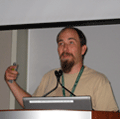
Northeastern University Marine Science Center 430 Nahant Road Nahant MA 01908 (781) 581-7370 e-mail author
Delivered at 2008 Boston Harbor Islands Science Symposium.
The role of native species diversity in providing biotic resistance to invasion remains controversial, with evidence supporting both negative and positive relationships that are often scale-dependent. Across larger spatial scales, positive relationships suggest that exotic and native species respond similarly to factors other than diversity such as island size and isolation. However, previous island studies examined only a few islands or islands separated by extreme distances. We surveyed exotic and native plant diversity on 23 islands separated by < 15 km in |
Last updated: February 26, 2015
